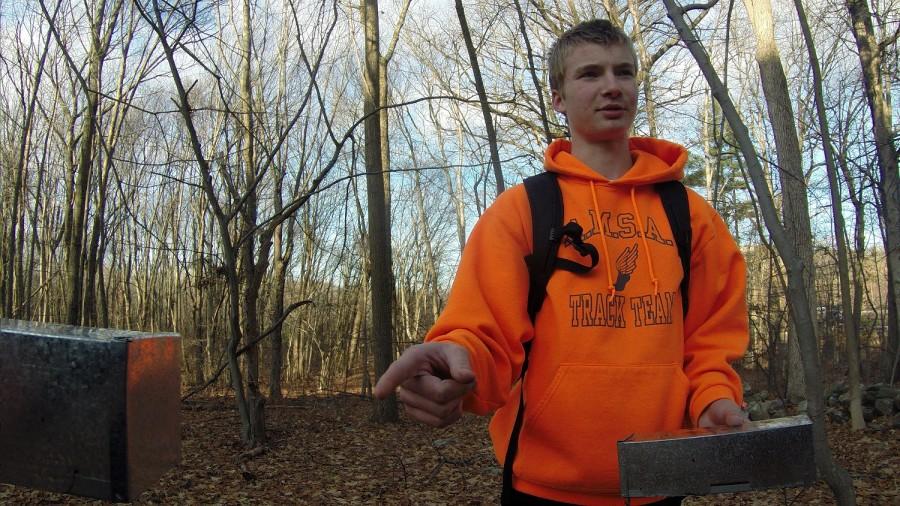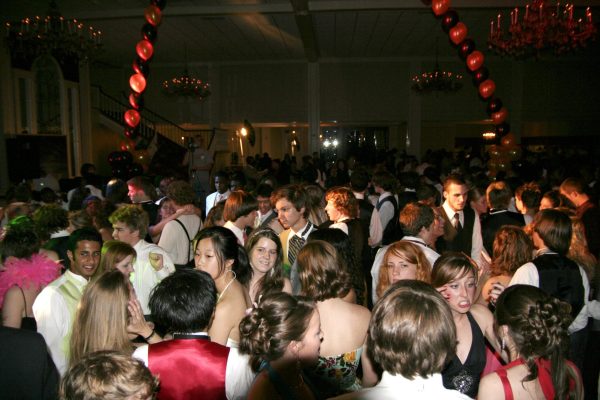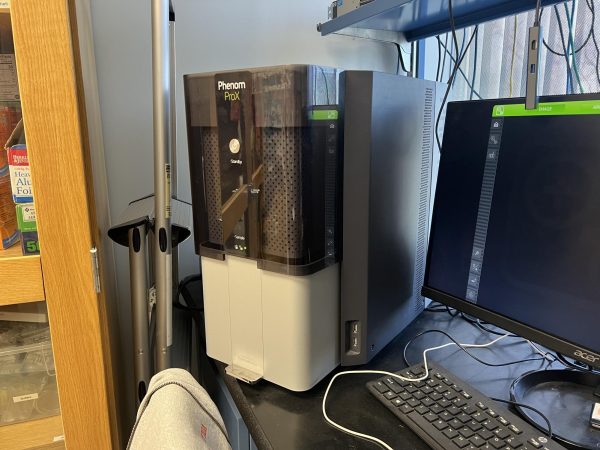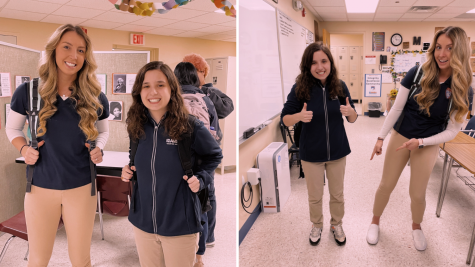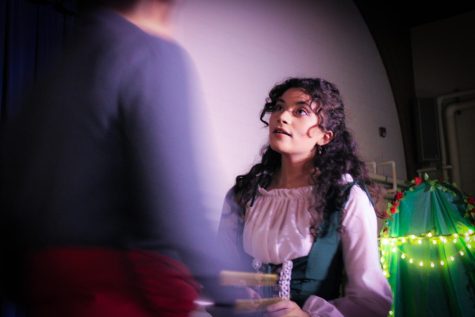Out of the classroom and into the field
EDITOR’S NOTE: First in a four-part series about AMSA’s innovative science research program
Junior Karl Lausten is working on field research to learn more about local wildlife.
AMSA science teachers have always tried to incorporate innovative tactics to make the sciences as hands-on and dynamic as possible.
From analyzing blood splattering in forensics to incorporating bunnies into the AP biology curriculum, the science department is constantly pushing creative boundaries.
Such efforts can be seen in the new science research program that was incorporated into the curriculum early this school year. This program creates a more vigorous and interactive learning experience for select students at the academy.
The goal of the research project is “to get the students to speak intelligently about the [research] project because they’ve done it, not just regurgitate something that someone told them to say,” said Dr. Scott Joray, the science department chair.
The research program, which gives students school credit, replaces a study hall and allows students to pursue their interests in a scientific field.
“This program is the next step in changing science education,” Dr. Joray said.
The program is an attempt to incorporate graduate-level studies into a high school curriculum. The program is divided into four groups: microbiology, sustainability, geochemistry, and wildlife biology. Each of these groups has a science teacher/mentor to guide students in their scientific explorations.
The wildlife biology group consists only of ninth grade biology teacher Andrew Couto and 11th grader Karl Lausten. Together they conduct ecological research in the Marlborough area. Their goal is to determine the population size of various Marlborough mammals using a variety of surveying techniques.
The long-term goal is to prepare students for a potential career in wildlife conservation by studying local species and their habitats.
“The aim is to open the students’ eyes to what types of things we share the environment with,” Mr. Couto said.
Starting the program was not an easy task, but it continues to grow in meaningful ways.
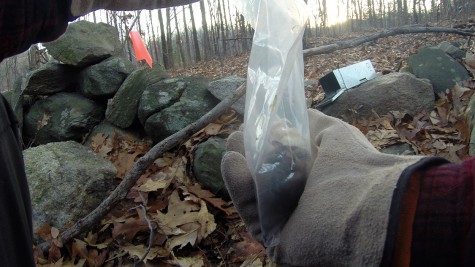
Junior Karl Lausten and teacher Andrew Couto have used traps to capture and study local mammals.
Dr. Joray wants to shy away from the traditional American education system and strive to create a more collaborative atmosphere.
“The fact that you can’t use any resources and can’t ask for clarity from a fellow student because it is determined as cheating—nowhere in life does that happen,” Dr. Joray said.
So Dr. Joray ran his ideas concerning collaboration by the teachers in his charge.
“Midway through last year Dr. Joray approached me and basically told me he wanted to do a research program incorporating wildlife research,” Mr. Couto said.
While Dr. Joray had full confidence in the program, the trick was getting teachers on board.
“It was horrible,” he said. “They thought research was something you do to get a Ph.D. I had to rephrase it and say: What are you passionate about?”
This put Mr. Couto at ease.
“In a 10-minute conversation we came up with a dozen ideas,” Mr. Couto said.
When Dr. Joray asked, If you could do anything what would you do? Mr. Couto thought about his studies at the University of Massachusetts-Amherst, where he majored in wildlife and fisheries conservation. From there, they were able to finalize an idea for wildlife biology research with an eye toward studies in conservation and habitats.
Dr. Joray’s main priority is to help students prepare for their post-graduate studies in a way that is practical and unforgettable.
“In life you work in teams and are encouraged to collaborate with people who have skill sets you don’t have,” Dr. Joray said.
Working together, Mr. Couto and Karl already have used two different techniques to analyze mammalian populations. Since this is only the first year of the program, they spend a great amount of time researching things online and planning what they will do when the program expands in the future.
They use motion-detector, infrared cameras and metal animal traps to survey the animals.
The cameras take pictures of animals that walk by, and are therefore useful in seeing which species are common in the Marlborough area.
The metal traps, which are loaded with cotton balls and the luring power of peanut butter, have been successful in catching mice and other small animals.
“We put out 10 [traps] over night and caught three animals,” Karl said.
The frigid winter temperatures and overwhelming snowfall made it difficult to conduct frequent outdoor experiments, but they are optimistically hoping that spring will make things easier.
Karl, for one, has always been interested in such a process, which makes the selling of the program easier.
“Two years ago I took Karl on a field trip and we helped out with a survey of terrapins, which are small sea turtles, on Cape Cod and Karl said he liked that type of biology more than the classroom stuff,” Mr. Couto said.
He instantly knew that Karl, who enjoys hiking, fishing, and mountain biking, would be a good fit.
“I liked this program because I could spend more time outside,” Karl said.
Karl noted that there are key differences between the research program and traditional courses at AMSA.
“It’s more about learning and skill development than grades,” he said. “You can have a lot more fun.”
The wildlife biology program next year will consist of nine students—quite an expansion considering Karl is currently going it alone.
Across the board, students and teachers alike have seen that forgoing written tests and a lack of formal homework assignments have not led to idleness among young researchers.
“Karl gave himself homework,” Mr. Couto said. “We were reading scholarly articles […] and Karl chose to bring it home and read it.”
Their goals for the rest of the year are ambitious.
“Continue skill development […] collect some data using a mark-recapture study and get some more done on our survey,” Mr. Couto said when asked about the program’s future goals.
Although hesitant at the beginning of the process, he is excited that the research program has been implemented into AMSA’s already rigorous curriculum.
“Next year will be much more data-intensive,” Mr. Couto said. “We will hit the ground running.”
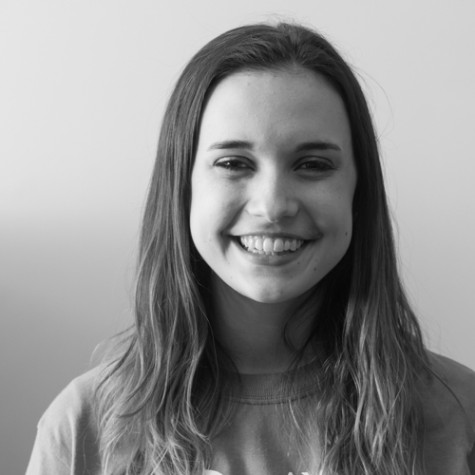
Alli Caulfield is a co-editor of The AMSA Voice. She is a senior and a resident of Leominster. She hopes to attend college in a big city to pursue her...


